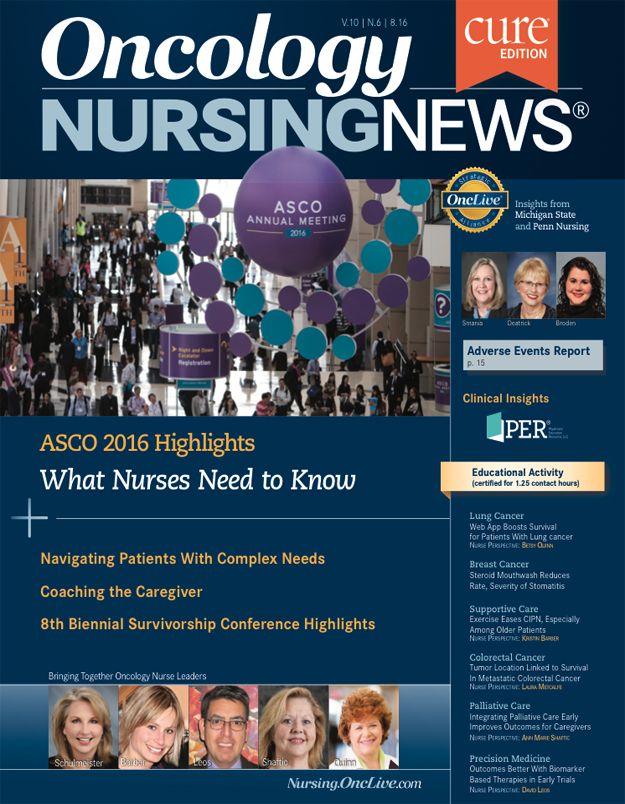Identifying Patients and Families at Risk for Cancer
With approximately 5% to 10% of cancers attributable to a hereditary cancer predisposition syndrome, identifying those patients with cancer who are at risk has significant benefit both to patients and their relatives.
Mary Smania, DNP, FNP-BC, AGN-BC

Mary Smania is a board-certified Advanced Genetics Nurse and Assistant Professor, Health Programs, at Michigan State University College of Nursing in East Lansing
The scientific and clinical knowledge in cancer genetics and genomics is rapidly advancing, with new findings in many areas, including genetic mutations and sequencing, risk-reduction strategies, and targeted treatment. With approximately 5% to 10% of cancers attributable to a hereditary cancer predisposition syndrome, identifying those patients with cancer who are at risk has significant benefit both to patients and their relatives.1
Oncology patients’ medical management can be personalized based on their genetic information, and the ability to perform genetic testing on family members can yield a more specific risk assessment and initiation of appropriate screening and prevention strategies.
Clinical application of cancer genetics and genomics involves interprofessional teams. Oncology nurses, as members of these teams, play a key role in identifying and supporting patients with, or who are at risk, of a genetic cancer. Family history can be an essential tool in recognizing individuals who have an inherited predisposition to malignancy or who are at an increased risk for additional primary cancers. Identification of those patients requires assessment and evaluation of the family history, with a minimum of a three-generation pedigree.2
The oncology nurse should have the knowledge and skill to collect and record the family history, identify areas of disease susceptibility or a genetic/genomic condition, and to understand standard pedigree nomenclature.
The Genetics and Genomics Nursing Competencies describe the importance of a nursing assessment in collecting a patient’s personal history and three-generation family history to assess for genomic factors that impact the patient.3 After collecting a family history, the nurse can then identify those patients who might benefit from referral to genetic specialists or information facilitating those appropriate referrals to specialists as needed.
In addition, the competencies point out that it is essential for nurses to understand standard pedigree nomenclature and describe the type of information to be collected in a family history, including4:
- Disease and age of onset, ethnicity, both maternal and paternal lineages
- Three-generation pedigree: first-degree relatives (siblings, parent’s children); second-degree relatives (grandparents, aunts, uncles, grandchildren, nieces, nephew, half siblings)
- Results of any genetic testing in any relative
The competencies specifically require that nurses understand the tools to assist families in recording family history, such as the Surgeon General’s Family History tool.5
There are many ways to take a family history, ranging from the patient’s own computer or paper questionnaires, to interviews with direct questions asked in a systematic way as part of an intake into care. The method of collecting information depends on each clinical situation and the abilities of the patient. A pedigree is a way to record family history by drawing a family tree. A pedigree represents family members and relationships using standardized symbols, and as a graphic representation of a patient’s family history and relationships, allows nurses to see patterns of disease.
During the assessment of the patient and family history, the nurse should be aware of the patient and family responses and perceptions. There may be cultural, ethnic, religious, or social issues that influence a patient’s knowledge and attitude toward genetic testing. Other concerns the patient may have are related to the impact of the information on their family or community. The nurse competencies emphasize the importance of the oncology nurse understanding the cultural and religious aspects of the patient and an awareness of their own attitudes and values which may affect care.
Finally, it is essential for the oncology nurse to develop a plan of care incorporating the assessment of the family history.6 The Genetic and Genomic Nursing Competencies define this as the ability to critically analyze the assessment findings for genetic and genomic influences and risk factors. When those genetic risk factors are identified, the oncology nurse can then appropriately provide resources and referrals for patients and families.
The oncology nurse has a vital role in the collection and use of family cancer history. Nurses are well suited to provide this care as they spend many hours developing therapeutic relationships with patients and their families. Through the family history and pedigree, the nurse, as a key member of the healthcare team, can identify individuals with cancer who are at increased risk for additional primary cancers and genetic risk factors that can affect treatment, screening, and prevention options for not only the cancer patient, but also at-risk relatives.
Resources for Family History Collection
- CDC: Family history http://www.cdc.gov/genomics/famhistory
- US Department of Health and Human Services: Surgeon General’s Family History http://www.hhs.gov/familyhistory/
Resources to Assist With Patient Referrals
- National Society of Genetic Counselors www.nsgc.org
- National Cancer Institute Cancer Genetic Services Directory www.cancer.gov/cancertopics/genetics/directory
- American College of Medical Genetics Provider Directory www.acmg.net/GIS/Disclaimer.aspx
- American Board of Medical Genetics http://www.abmg.org
References
1. American Cancer Society. Cancer Facts and Figures 2016. http://www.cancer.org/research/cancerfactsstatistics/cancerfactsfigures2016/. Accessed July 31, 2016.
2. Valdez R, Yoon PW, Qureshi N, et al. Family history in public health practice: A genomic tool for disease prevention and health promotion. Annu Rev Public Health. 2010;31:69-87.
3. Consensus Panel on Genetic/Genomic Nursing Competencies. Essentials of Genetic and Genomic Nursing: Competencies, Curricula Guidelines, and Outcome Indicators, 2nd ed. Silver Spring, MD: American Nurses Associatio. http://www.aacn.nche.edu/education-resources/Genetics__Genomics_Nursing_Competencies_09-22-06.pdf. Accessed Julu 31, 2016.
4.Bennett RL, French KS, Rest RG, et al. Standardized human pedigree nomenclature: Update and assessment of the recommendations of the national society of genetic counselors. J Genet Counsel. 2008;17(5):424-433.
5. US Department of Health and Human Services. Surgeon General’s My Family Health Portrait. https://familyhistory.hhs.gov/FHH/html/index.html#. Accessed July 31, 2016.
6. Lu KH, Wood ME, Daniels M, et al. American Society of Clinical Oncology Expert Statement: Collection and Use of a Cancer Family History for Oncology Providers. J Clin Oncol. 2014;32(8):833-840.
Innovative Program Reduces Nurse Turnover and Fosters Development
Published: September 12th 2024 | Updated: September 12th 2024The US Oncology Network (The Network) has developed one of the most comprehensive programs in the nation to support the professional development and retention of new oncology nurses.



